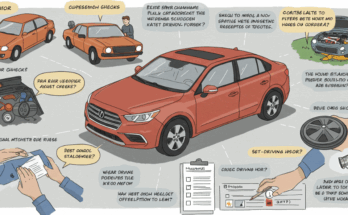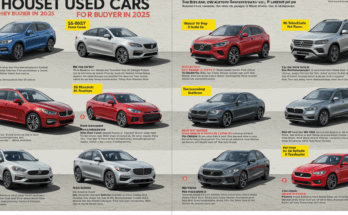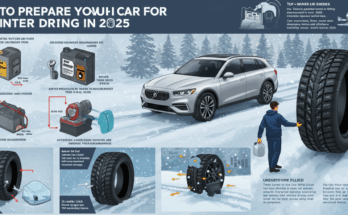Choosing the right SUV for your family can feel like picking the perfect vacation spot—exciting but overwhelming with all the options. Whether hauling kids to soccer practice, planning a weekend camping trip, or navigating the daily grind, your SUV must fit your life like a glove. I’ve been there myself—standing in dealership lots, scrolling endless reviews, and wondering, “Will this work for us?” After plenty of trial, error, and research, I’ve got you covered with a no-nonsense guide to finding the family SUV of your dreams.
Let’s break it down step-by-step, with real-world examples and some expert-backed tips to help you make a choice you’ll love for years.
Why an SUV Makes Sense for Families
SUVs have become the go-to for families, and it’s no surprise why. According to the National Highway Traffic Safety Administration (NHTSA), SUVs accounted for over 50% of U.S. vehicle sales in 2023—a clear sign they’re meeting real needs. They offer more space than sedans, better visibility than minivans (without the “soccer mom” stereotype), and the versatility to handle everything from groceries to gravel roads.
Take my friend Sarah, for example. She swapped her compact sedan for a midsize SUV last year after her second kid arrived. “I couldn’t cram the stroller, diaper bag, and groceries into my old car anymore,” she told me. “The SUV was a game-changer—room for everyone and everything.” That’s the magic of an SUV: it grows with your family.
But with so many models—compact, midsize, full-size, hybrid—how do you pick the right one? Let’s dive into the key factors.
Step 1: Assess Your Family’s Needs
Before you glance at a shiny brochure, sit down and think about what your family needs. This isn’t about impressing the neighbors—it’s about function.
-
- How many people are you hauling? A compact SUV like the Honda CR-V might be fine for a family of three, while a crew of six needs a third-row beast like the Toyota Highlander.
-
- What’s your cargo situation? If you’re the type who overpacks for road trips (guilty!), prioritize cargo space—think 60 cubic feet or more behind the second row.
-
- Daily grind vs. weekend warrior: Are you mostly commuting or need off-road capability for adventures? My cousin Mike learned this the hard way when his city-friendly SUV got stuck on a muddy trail last summer.
Jot down your must-haves: seating, storage, fuel economy, and each. It’s like making a grocery list. Stick to it, or you’ll have something you don’t need.
Step 2: Set a Realistic Budget
SUVs come in all price ranges, from the wallet-friendly Kia Seltos (around $24,000) to the luxurious Mercedes-Benz GLE (pushing $60,000+). Edmunds reports the average SUV price in 2024 hovered around $42,000, but don’t let that scare you—there are gems at every level.
Consider long-term costs, too. Gas, insurance, and maintenance add up. My neighbor Tom swears by his hybrid Ford Escape, which saves him $800 a year on fuel compared to his old gas-guzzler. Check sites like Kelley Blue Book for total cost-to-own estimates—five-year projections can reveal hidden savings.
Pro tip: Used SUVs can be a sweet spot. A 2021 model with low mileage might save you thousands without sacrificing modern features.
Step 3: Prioritize Safety First
When it’s your family in those seats, safety isn’t negotiable. The Insurance Institute for Highway Safety (IIHS) ranks SUVs annually, and top picks like the Subaru Forester and Mazda CX-5 consistently earn “Top Safety Pick+” honors for their crash-test performance and advanced driver-assistance systems (ADAS).
Look for these must-have safety features:
-
- Automatic Emergency Braking (AEB) stops the car if you don’t react in time—perfect for distracted parent moments.
-
- Lane Departure Warning: Keeps you from drifting on those sleepy morning drives.
-
- Rearview Camera + Sensors: Because backing out with kids running around is nerve-wracking.
Sarah’s SUV has blind-spot monitoring, and she says it’s saved her from merging mishaps more than once. Check NHTSA ratings (5 stars is the goal) and test-drive the tech yourself—some systems are more intuitive than others.
Step 4: Size Matters—Choose the Right Fit
SUVs come in three primary flavors: compact, midsize, and full-size. Here’s the rundown:
Compact SUVs
-
- Best for Small families or urban dwellers.
-
- Examples: Toyota RAV4, Honda CR-V.
-
- Pros: Easy to park, excellent fuel economy (30+ MPG).
-
- Cons: Tight third rows (if they even have one).
Midsize SUVs
-
- Best for: Growing families or road-trippers.
-
- Examples: Jeep Grand Cherokee, Hyundai Palisade.
-
- Pros: More legroom, decent towing (up to 5,000 lbs).
-
- Cons: Trickier in tight parking lots.
Full-Size SUVs
-
- Best for: Big families or heavy-duty needs.
-
- Examples: Chevrolet Suburban, Ford Expedition.
-
- Pros: Massive space, towing up to 8,000 lbs.
-
- Cons: Gas hogs (15-20 MPG) are pricey.
I test-drove a midsize last month and loved the balance—roomy enough for my crew but not a beast to maneuver. Pick based on your lifestyle, not just “bigger is better.”
Step 5: Test Drive Like Your Life Depends on It
You wouldn’t buy a house without walking through it, right? The same goes for an SUV. Schedule test drives for your top three picks—dealerships are happy to oblige. Bring the family, the car seats, and even the dog. See how it feels.
-
- Comfort: Are the seats supportive? Can kids climb in easily?
-
- Controls: Is the infotainment system user-friendly or a tech nightmare?
-
- Noise: Listen for road hum—quiet cabins make long drives peaceful.
Mike regrets skipping this step—his SUV’s stiff ride annoys him daily. Spend 20 minutes behind the wheel, and you’ll know if it’s a keeper.
Step 6: Think Long-Term—Resale and Reliability
A family SUV isn’t a fling; it’s a commitment. J.D. Power’s 2024 Dependability Study highlights brands like Toyota and Lexus for fewer issues over time. Resale value matters too—Kelley Blue Book notes the Toyota 4Runner retains over 60% of its value after five years.
Hybrid options, like the Toyota Highlander Hybrid, are gaining traction for their efficiency and longevity. Tom’s hybrid is still going strong at 80,000 miles with minimal repairs. Check owner forums for real-world reliability scoop—numbers don’t lie, but stories add color.
Bringing It All Together
Choosing the perfect SUV is about aligning your family’s needs with the right features, budget, and feel. Sarah’s thrilled with her midsize pick, while Mike’s planning to trade up after his off-road flop. Me? I’m leaning toward a hybrid compact—fuel savings and enough space for chaos.
Start with your list, narrow it down, and hit the road for a test drive. You’ll know “the one” when you feel it. Happy hunting—your family’s perfect ride is out there waiting!
Choosing the Perfect Family SUV
What’s the best SUV for a family of five?
Midsize SUVs like the Hyundai Palisade or Kia Telluride offer ample seating and cargo space for five, with optional third rows for extras.
Are SUVs safe for families?
Yes, many SUVs score high in safety tests. Look for IIHS Top Safety Picks with features like AEB and blind-spot monitoring.
Should I buy a new or used SUV?
New gets you warranties and the latest tech; used saves money. A 2-3-year-old model with low mileage often strikes the best balance.
What’s the most fuel-efficient family SUV?
Hybrids, such as the Toyota RAV4 Hybrid (40 MPG combined) or Ford Escape Hybrid, lead the pack in efficiency without sacrificing space.
How do I know if an SUV fits my family?
Test drive it with everyone aboard—check the car seat fit, legroom, and storage. If it feels cramped, size up!




